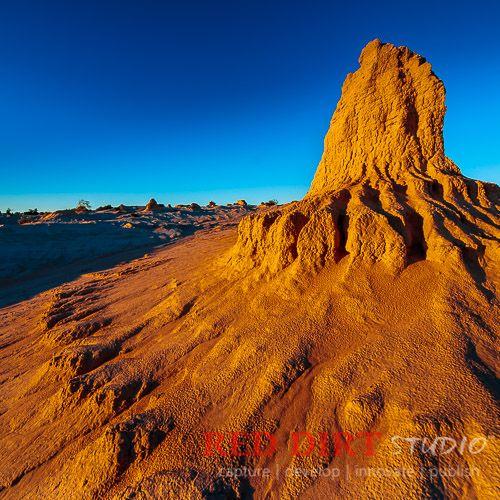Stock & Editorial Photography: Capturing the Essence of Lake Mungo
Images of Outback NSW
 In theory, Lake Mungo National Park is nothing more than the remnants of an ancient lake (completely dry and with ancient dunes running twenty-plus kilometres along one side) in the middle of the New South Wales outback. But in reality, Lake Mungo is one of the world's most significant anthropological and archaeological sites.
In theory, Lake Mungo National Park is nothing more than the remnants of an ancient lake (completely dry and with ancient dunes running twenty-plus kilometres along one side) in the middle of the New South Wales outback. But in reality, Lake Mungo is one of the world's most significant anthropological and archaeological sites.
The much-photographed 'Walls of China' is something all visitors should experience, as is the story the landscape reveals.
This is a remarkable place; its international significance is recognised with a World Heritage listing.
It's where you'll find the Walls of China, an icon not only for the sheer beauty of dramatic formations but also for the amazing spiritual significance of the area.
Mungo has evidence of continual human habitation over 40,000 years.
Lake Mungo is one of 17 Willandra Lakes World Heritage Area dry lakes.
The awesome Walls of China emerged over eons, as winds blowing across the dry bed of the lake collected sediment and deposited it on the western shore.
This forms an elevated bank that extends almost 20 km along the side of the lake. The layers of sedimentary sands and clays have been eroded by wind and rain to form a spectacular lunette, offering stunning photo opportunities in the changing light.
The lakes last experienced permanent water over 10,000 years ago. Here, Aborigines gathered mussels, fished for Murray cod and golden perch, hunted wallabies and rat kangaroos and collected emu eggs.
Evidence of this activity remains in ancient fireplaces, indigenous burial sites, and fossilised remnants of extinct species such as the short-faced kangaroo.
There is also a glimpse into the former European occupation. The area was an operational sheep station before becoming a national park and many heritage buildings remain.
It is just over 1-hour drive from Wentworth and about 1 hour from the Darling River near Pooncarie.
Autumn, winter and spring are the best times to visit, avoiding the extreme summer heat.
Touring Lake Mungo
Touring Mungo National Park
Lake Mungo is a remarkable place and a must for anyone travelling through the lower Darling River area of Outback NSW - especially if doing the Darling River Run!
The region is so exquisite and ethereal that a World Heritage listing recognises it. It is where you’ll find the Walls of China, an icon not only for the sheer beauty of dramatic formations but also for the tremendous spiritual significance of the area.
Lake Mungo is unique to anthropology as the lake and dunes have revealed evidence of continual human habitation of 60,000+ years.
The lake is one of 17 dry lakes that form the Willandra Lakes (World Heritage Area), and the evocative Walls of China have been created over the millennia through a process of both wind and rain; sediment has been deposited on the eastern bank of the dry lakebed and has, in turn, been eroded by the rain to reveal a myriad of textures and colours.
The Route:
Wentworth <> Mungo National Park - Distance = 155 km - about 2.5 hours:
- Wentworth Pooncarie Rd (Sealed), 86 km
- Top Hut Rd (Dry weather road) 66 km
Pooncarie <> Mungo National Park: - Distance = 97 km - about 2 hrs
- Wentworth Pooncarie Rd (Sealed), 31 km
- Top Hut Rd (Dry weather road) 66 km
Visitor Information
Mungo National Park Visitor Information:
-
Mungo National Park See & Do...
- Foreshore walk
- Grasslands Nature trail
- Mallee Stop walking track
- Mungo lookout
- Mungo Self-guided Drive tour
- Mungo Visitor Centre
- Mungo Woolshed
- Red Top lookout
- Walls of China viewing platform
- Zanci Homestead site
-
Mungo National Park Information Centre:
- Park Office: Corner of Sturt Highway and Melaleuca Street, Buronga NSW
- Telephone 03 5021 8900
